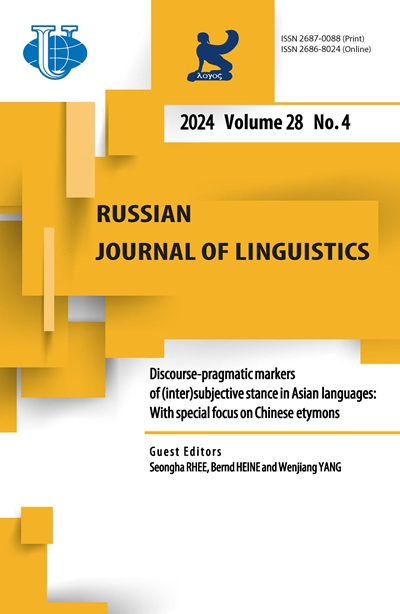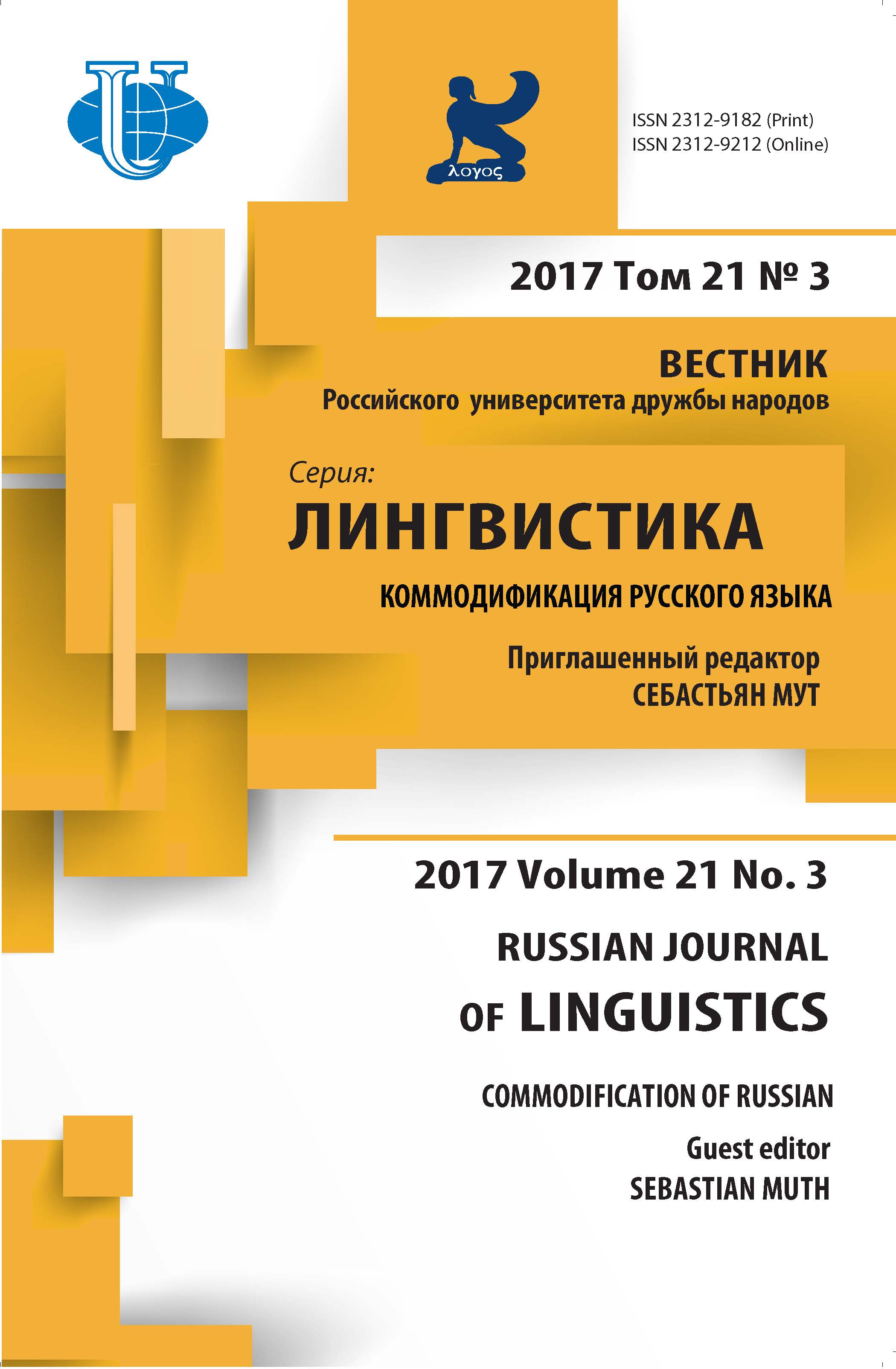РОЛЬ РУССКОГО ЯЗЫКА В СФЕРЕ МЕДИЦИНСКИХ УСЛУГ ИНДИИ
- Авторы: Сурьянараян Н.1
-
Учреждения:
- Делийский университет
- Выпуск: Том 21, № 3 (2017): Коммодификация русского языка
- Страницы: 515-529
- Раздел: Статьи
- URL: https://journals.rudn.ru/linguistics/article/view/16789
- DOI: https://doi.org/10.22363/2312-9182-2017-21-3-515-529
Цитировать
Полный текст
Аннотация
Ключевые слова
Об авторах
Нилакши Сурьянараян
Делийский университет
Email: neelakshi55@yahoo.co.in
Нилакши Сурьянараян, кандидат филологических наук, профессор, заведующая кафедрой славянских и финно-угорских исследований Делийского университета, Индия. Выпускница РУДН. Преподает русский язык, литературу и культурологию. Является членом международного научного сообщества ENIEDA и других профессиональных и научных ассоциаций, а также редколлегий научных журналов, включая «Вестник Российского университета дружбы народов. Серия: Лингвистика». Сфера научных интересов: сопоставление речевого этикета в индийских языках, русском и английском, лингвопрагматика, коммодификация русского языка в XXI в. Delhi University, 110007 Delhi, India
Список литературы
- Babu, P. G., and Anjaneya Swamy, G. (2007) Medical Tourism: An analysis with special reference to India. Journal of Hospitality Application and Research, 2, 1: 31-48.
- Chuang, T. C., Liu, J. S., Lu, L. Y. Y., & Lee, Y. (2014) The main paths of medical tourism: From transplantation to beautification. Tourism Management 45, 49-58.
- Coulmas, F. (2005) Changing language regimes in globalizing environments. International Journal of the Sociology of Language, 175/176: 3-15.
- Connell, J. (2013) Contemporary Medical Tourism: Conceptualisation, Culture and Commodification. Tourism Management, 34: 1-13.
- Connell, J. (2015) Transnational health care: Global markets and local marginalisation in medical tourism. In P. Bronwyn, B. Greenhough, T. Brown, and I. Dyck (eds.) Bodies across borders: The global circulation of body parts, medical tourists and professionals. Farnham: Ashgate, 75-94.
- Crooks, V. A., Turner, L., Snyder, J., Johnson, R., and Kingsbury, P. (2011) Promoting Medical Tourism to India: Messages, Images, and the Marketing of International Patient Travel. Social Science and Medicine, 72: 726-732.
- Duchêne, A. (2009) Marketing, management and performance: Multilingualism as commodity in a tourism call centre. Language Policy 8: 27-50.
- Duchêne, A. (2011) Néolibéralisme, inégalités sociales et plurilinguismes: l’exploitation des ressources langagières et des locuteurs. Langage & Société, 136: 81-106.
- Harvey, D. (1989) The Condition of Postmodernity: An Enquiry into the Origins of Cultural Change. Oxford: Wiley-Blackwell.
- Heller, M. (2003) Globalization, the New Economy, and the Commodification of Language and Identity. Journal of Sociolinguistics, 7 (4): 473-492.
- Heller, M. (2010) The Commodification of Language. Annual Review of Anthropology, 39: 101-114.
- Heller, M., and Duchêne, A. (2012) Pride and Profit: Changing Discourses of Language, Capital and Nation State. In A. Duchêne, and M. Heller (eds.) Language in Late Capitalism: Pride and Profit. New York and London: Routledge, 1-21.
- Heller, M. and Duchêne, A. (2016) Treating language as an economic resource: Discourse, data, deba¬tes. In N. Coupland (ed.) Sociolinguistics: Theoretical Debates. New York: Cambridge Univer¬sity Press, 139-156.
- Jones, C. A., and Keith, L. G. (2006) Medical Tourism and Reproductive Outsourcing: The Dawning of a New Paradigm for Health-care. International Journal of Fertility and Women’s Medicine, 51: 251-255.
- Kaspar, H. (2015) Private hospitals catering to foreigners underestimate interpreters' role. Hindustan Times. Retrieved from: http://www.hindustantimes.com/ht-view/private-hospitals-catering-to-foreigners underestimate-interpretersrole/storyqqE4UDCcB6b0EaW8TyuOQN.html
- Milstein, A., and Smith, M. (2006) America‘s New Refugees - Seeking Affordable Surgery Offshore. New England Journal of Medicine, 355: 1637-1640.
- Muth, S. (2017) Russian as a commodity: medical tourism and the healthcare industry in post-Soviet Lithuania. In S. Muth and L. Ryazanova-Clarke (eds.) The commodification of Russian around the world (Special issue). International Journal of Bilingual Education and Bilingualism, 20(4): 404-416.
- Ollapally, D. (2002) Indo-Russian Strategic Relations: New Choices and Constraints. Journal of Stra¬tegic Studies 25 (4): 135-156.
- Pant, H. V. (2013) India-Russia Ties and India’s Strategic Culture: Dominance of a Realist Worldview. India Review, 12 (1): 1-19.
- Pavlenko, A. (2012) Commodification of Russian in post-1991 Europe. In M. Bär, A. Bonnet, H. Pav¬lenko, A. (2013) Language management in the Russian empire, Soviet Union, and post-Soviet countries. In R. Bayley, R. Cameron, and C. Lucas (eds.) The Oxford Handbook of Socio-lin¬guistics. Oxford: Oxford University Press, 651-679.
- Pavlenko, A. (2017) Russian-friendly: how Russian became a commodity in Europe and beyond. In S. Muth and L. Ryazanova-Clarke (eds.) The commodification of Russian around the world (Special issue). International Journal of Bilingual Education and Bilingualism, 20(4): 385-403.
- Tan, P, and Rubdy, R. (2008) (eds.) Language as Commodity: Global Structures and Local Market¬places. London: Continuum.
- Sahai, S. (1990) The Delhi Declaration: Cardinal of Indo-Soviet Relations. New Delhi: Mittal.
- Suryanarayan, N. (2017) From Yashwant Place to Yashka: a case study of commodification of Russian in India. In S. Muth and L. Ryazanova-Clarke (eds.) The commodification of Russian around the world (Special issue). International Journal of Bilingual Education and Bilingualism, 20(4): 428-442.
- Viladrich, A., and Baron-Faust, R. (2014) Medical Tourism in Tango Paradise: The Internet Branding of Cosmetic Surgery in Argentina. Annals of Tourism Research, 45 (3): 116-131.

















